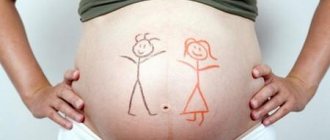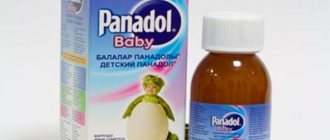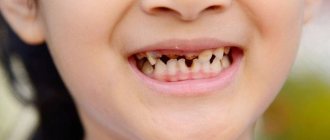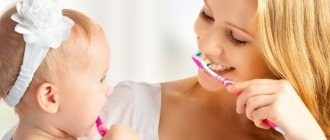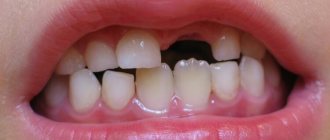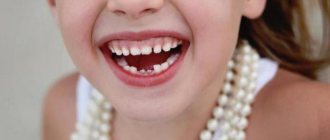The change of teeth in children begins to occur from the age of 5-6, when the roots of baby teeth (not everyone knows about this) dissolve, and the baby teeth are replaced by “adult”, permanent ones.
The first loose baby tooth always causes a storm of emotions - both for the child and for the parents. But is there a need to rush to remove it?
And if it is still necessary, then how to do it correctly?
But, if the teeth have already begun to loosen, it is still not recommended to rush to remove them, because they...
- Promotes proper eruption and further placement of molars in the mouth.
- Stimulates proper growth and direct development of the jaw bone.
- Promotes the necessary development of chewing muscles.
- They preserve those places that are important for the eruption of molars.
That is why experts advise not to rush into searching for original methods of milk tooth removal - but, on the contrary, to try to preserve them for as long as possible, not forgetting about the child’s proper nutrition and regular teeth cleaning.
12 Effective Ways to Get Your Young Child to Brush Their Teeth
Why should you not remove baby teeth ahead of time?
- The loss of a baby tooth can be called premature or early if you wait more than a year before the molar appears. The place of the lost tooth will quickly be taken by the remaining “brothers”, and over time the permanent tooth will simply have nowhere to erupt, and the remaining molars will appear chaotically. The result is an incorrect bite and subsequent complex treatment by an orthodontist.
- The second, most common negative consequence is a change in the rate of jaw development, which also leads to deformation of the entire dentition. The teeth will not have enough space, and they will begin to “climb” on top of each other.
- Early tooth removal can cause the formation of a bone scar in the gum socket or even atrophy of the alveolar margin. In turn, these changes will lead to difficulties in cutting new teeth.
- There is a high risk of injury to the growth plate and disruption of normal jaw development.
- Wearing and damage to incisors due to increasing chewing load after removal of chewing teeth. The result is a lack of stimulation of the masticatory muscles and improper growth of the molars.
Complications such as...
- Root fracture or nerve damage.
- Pushing the tooth into soft tissue.
- Root aspiration.
- Fracture of the alveolar process.
- Injury to adjacent teeth.
- Damage to the gums.
- And even a dislocated jaw.
This is why dentists recommend removing baby teeth only for special reasons. And even with special indications, they are looking for a way to save the tooth until the permanent one erupts.
And, of course, if you still had to contact a dentist, then you should choose him especially carefully - only a professional and experienced specialist.
Absolute indications for such intervention include...
- Delayed root resorption when the growth of a permanent tooth has already begun.
- The presence of an inflammatory process in the gums.
- Serious discomfort experienced by a baby due to a loose tooth.
- The presence of a resorbed root (visible in the picture) and a loose tooth, which should have fallen out long ago.
- Destruction of a tooth by caries to the extent that its restoration is impossible.
- Presence of a cyst on the root.
- Tooth injuries.
- The presence of a fistula on the gum.
How a dentist removes baby teeth from a child - preparation for going to the doctor and the procedure itself
It’s not for nothing that children’s doctors do the removal of baby teeth. The thing is that removing children's teeth requires special skills. Milk teeth have rather thin alveolar walls and have thinner (and longer) roots than molars.
Also important are the rudiments of permanent teeth, the structural features of the growing baby’s jaw, and a mixed bite. One careless movement and the rudiments of permanent teeth can be damaged.
All these factors require increased caution and professionalism from the doctor.
Not to mention that a child is always a complex patient who requires a special approach.
Contraindications to extraction at home
Deep caries
It is not always acceptable to pull out a child’s baby tooth at home. There are two contraindications – the tooth is not ready for extraction and the presence of diseases. In the first case, you don’t need to do anything radical, you just have to wait until the “milk jug” starts to wobble more and falls out on its own or is ready to be removed.
We invite you to familiarize yourself with Metrogil-denta during pregnancy - BabyBlog
In the case when children’s teeth are pulled out due to advanced caries, a visit to dentistry is inevitable. An incisor destroyed by caries can crumble under any influence. Only a dentist with sufficient experience and special tools will be able to pull out the tooth completely and do it painlessly.
How is a baby tooth removed?
When the root resolves on its own, anesthesia is usually not required. In this case, only a special gel is used, which is used to lubricate the gums.
In serious cases, various drugs are used for pain relief, which are injected into the gums through a thin syringe needle.
In the most serious situations, general anesthesia may be required (for example, in case of intolerance to local anesthesia, in the presence of mental disorders or purulent inflammatory processes).
The tooth extraction procedure itself usually follows one scenario:
- Grasp the crown part of the tooth with forceps.
- Their further movement along the equator of the tooth and fixation on it without pressure.
- Luxation and removal from the socket.
- Next, the doctor checks whether all the roots have been removed and presses the hole with a sterile swab.
Preparing your child for the procedure - important tips:
- Don't frighten your child at the dentist. Such horror stories always backfire on parents: you can’t drag your child to the dentist even for a chocolate “bribe.”
- Get your child used to the dental office right from the cradle. Take him regularly for examinations so that the baby gets used to doctors and gets rid of fears.
- Take your child to the office with you when you go to have your teeth treated. The baby will know that mom is not afraid either, and the doctor does not cause pain.
- Don't show your child that you're worried about him.
- Do not leave your baby alone with the doctor. Firstly, the child needs your support, and secondly, anything can happen in your absence.
Caring for the child's psyche
So that over the years the child does not turn into an adult who trembles at the mere word “dentist,” you must definitely find a doctor for him who inspires confidence. A lot depends on the professionalism of the child specialist. Not the least important factor in preparing for a problem-free extraction is the attitude of the parents. They should remain calm and distract the baby, and not irritate him. It is imperative that mom or dad be with the child in the dental office.
Do not ignore the importance of baby teeth in the formation of a permanent bite. Treat them promptly in your child. Then his smile will always be healthy and beautiful.
Recovery after tooth extraction - what you need to remember
Of course, the specialist himself gives detailed recommendations for each specific case.
But there are some general tips that apply to most situations:
- The tampon inserted into the hole by the doctor is spat out no earlier than after 20 minutes.
- It is better not to bite your cheek at the anesthesia site (you must tell your baby about this): after the effect of the anesthesia wears off, very painful sensations may appear.
- A blood clot formed in the hole at the site of the extracted tooth protects the wound from dirt and helps in the rapid healing of the gums. Therefore, touching it with your tongue and rinsing it out is not recommended: the gums should close on their own without the child’s efforts.
- It is not recommended to eat for 2 hours after tooth extraction. Although some doctors recommend cold ice cream immediately after tooth extraction, it is better to abstain from any food intake. And within 2 days after removal, it is better to give up fermented milk products and hot dishes.
- During the gum healing period, only a soft toothbrush should be used.
- Swimming and physical activity in the next 2 days are also not recommended.
Action List
The easiest option to pull a tooth at home is to entrust this task to a child. Ask your baby to actively wiggle his tongue or give your baby some solid food, such as carrots or an apple. If the child is unable to remove it on his own, proceed as follows:
- Take a piece of sterile bandage or gauze.
- Wrap the bandage around your child's tooth.
- Rock it to the sides.
- Gently pull it down (if it is on the upper jaw) or up (if it is a lower tooth), making a twisting motion.
- Remove the tooth that has separated from the gum.
- Cover the wound with a gauze pad and have your child bite on it briefly.
You can also pull it out using thread. Just don’t tie it to the door with a thread, because this will pull the tooth to the side, which will create a fairly large wound. Having tied a high-strength silk thread to a loose tooth, pull it down or up, depending on its position in the oral cavity. In this case, the thread should be pulled sharply and quickly. To distract your baby, you can hold a toy airplane or your favorite soft toy at the end of a string.
You can see how to remove a tooth yourself using threads in the following video.
Video: 5 methods to help pull out a child’s baby tooth
If the tooth causes severe discomfort to the child, then a visit to the dentist should be made.
Also, you should not delay visiting a doctor if you observe redness, inflammation or a cyst near a given tooth.
In all other cases, it is recommended to simply wait until the time comes and the tooth begins to fall out on its own.
Be patient and prolong the life of your baby teeth as much as you can - this will save you from having to see an orthodontist.
If the time has come for a tooth to fall out, and it is already wobbly so much that it is literally “hanging by a thread,” then, in the absence of associated problems, you can carry out the removal yourself (if you are confident in yourself and your child is not afraid):
- First, give your baby a carrot or an apple. While the child is gnawing on the fruit, the tooth may fall out on its own. Rusks and hard cookies are not an option; they can injure the gums. If that doesn't help, proceed with removal.
- Make sure that you can actually remove the tooth yourself. Remember that if a tooth does not give in, this is the first signal that a dentist should take care of it, not your mother. Shake the tooth and determine whether it is truly ready for home removal.
- Rinse your child's mouth with a disinfectant solution (for example, chlorhexidine).
- You can use a pharmacy pain-relieving gel or fruit-flavored spray if your baby is very afraid of pain.
- (and your hands) with the same solution
- Tie the treated floss around the tooth , distract the child - and at this moment sharply and quickly pull out the tooth, pulling it in the direction opposite to the jaw. You should not pull to the side or make special efforts - this will cause the child to feel pain, and the integrity of the gums may be compromised.
- After tooth extraction, we proceed in the same way as after a visit to the dentist : hold a cotton swab on the hole for 20 minutes, do not eat for 2 hours, and eat only cool and soft food for 2 days.
Important Tips
Home removal is not one of the procedures recommended by doctors, but if there is no other option and you can’t persuade your child to go to the dentist, use the following useful tips:
- Take your time. Let the child himself try to push the loose element out of the jaw using his fingers and tongue. The baby understands his feelings better and does not hurt himself. Come to help if the child cannot cope on his own.
- Prepare yourself psychologically and prepare your baby. Come up with a ritual for saying goodbye to your tooth. Give a toy for courage, do not forget to praise the brave man.
- A bandage for wrapping a finger or thread is disinfected with alcohol, iodine, and brilliant green.
- Before removing teeth, you need to brush them and rinse your mouth with Rotokan.
- For pain relief in case of severe discomfort, the gums and cheek are treated with a teething gel for infants with lidocaine and a crushed analgin tablet.
- Pull the tooth 30-40 minutes after eating.
- If blood appears on the gum, ask the child to spit it out, do not allow him to swallow.
- The bleeding will quickly stop, the gums will not swell if you apply a cold compress to your cheek, or even eat ice cream. Give your kids a teaspoon of sweets 10–15 minutes after the procedure.
- Replace unpleasant memories with positive emotions. Praise the child again, tell relatives about his courage. Fear and fright on the wave of pleasant impressions and gifts will pass faster.
We invite you to familiarize yourself with Kamistad - instructions for using the gel, price, reviews, analogues
What's next?
- And then - the most interesting! Because the tooth fairy is already waiting for her tooth under your child’s pillow and is ready to exchange it for a coin (or for something else that you have already promised your child).
- Or give a tooth to a mouse so that the molar in the free space grows strong and healthy.
- You can also leave the tooth on the windowsill for the tooth owl , which takes milk teeth from the windowsills at night. Just don’t forget to write a note with a wish for the owl (the owl is magical!).
The main thing is not to worry! It depends on the parents whether the child will perceive his first tooth extraction as an exciting adventure - or remember it as a terrible nightmare.
Preparing the child
When the tooth is already loose enough to interfere with the child, you can proceed to the extraction procedure.
Some parents (on the advice of “all-knowing” grandmothers) try to do this suddenly, asking the baby to open his mouth so that the mother can “just look at the tooth.”
Most often, the result of such actions is predictable: tears, hysteria, panic fear of toothache and loss of trust not only in parents, but in the whole world - after all, if mom deceived, then others can do the same too.
That is why it is important to talk frankly with the baby, psychologically preparing him for the removal procedure:
- Explain that he has grown up, so his baby teeth, which are intended for babies, fall out, leaving room for new, strong “adult” teeth. But in order for them to grow up even and beautiful, you need to help them a little by taking out an “old” tooth from the gum.
- You shouldn’t assure your baby that “it won’t hurt at all” - after all, this is not true, and having felt unpleasant sensations, the baby will also feel offended that he was deceived. It’s better to say that it will be unpleasant, and perhaps even painful, but very quickly, and it’s worth being a little patient.
- Be sure to tell your little one an exciting story about the magical Tooth Fairy, who takes away the baby tooth placed under the pillow, leaving coins, toys or other pleasant surprises in return.
